HighScreen Cosmo Review: Template Break

As I remember now, the first Android smartphone that appeared in Russia is HighScreen PP5420. I was then haunted by nightmares for six months, from which I woke up in the middle of the night in a cold sweat - he was so ugly, this HighScreen. The following devices with this nameplate on board, too, were not inspired, to put it mildly, scaring away buyers with a disgusting assembly, lousy materials and an unknown name. But the other day, a new model - Cosmo - nevertheless fell into the hands, and it became clear that the monster could one day turn into a beauty.
Design
If HighScreen were not written on the back cover of this smart, I would have thought that someone from the “big league” had a hand in it. Terrible low-quality plastic and poor assembly are a thing of the past, and in my hands it turned out to be a budget, but high-quality device, even at first glance. I tried to squeeze it in every way - it holds - it does not even creak at all. This is apparently a “side effect” of the assembly at the Compal Electronics factory. At the same time, curiously, the price remained at the Heiskrin level.

Recently, "shovels" such as Desire HD have become popular among people, and after them Cosmo, despite the fact that it lies perfectly in the hand, it seems a little toy.

Display
The screen, of course, no longer impresses with the picture quality and the diagonal - a 3.2-inch display based on a TFT-matrix with a resolution of 320 x 480 pixels - this is now usual. Not very high viewing angles of the order of 140 degrees in both planes. The brightness and contrast are in order, but again, nothing outstanding ...
But then someone there finally came up with the idea that to recess the display in the thickness of the case is no longer just a bad manners, but a crime. Hallelujah! Dust and pocket villi will no longer accumulate in the corners! And even a capacitive sensor was added. Of course, it could have been much more responsive, but definitely better than the outdated resistive that was used in all previous models.
Iron
Hardware stuffing, like everything else in Cosmo, is not something outstanding. The Qualcomm MSM7227 processor, clocked at 600 MHz, in combination with 256 MB of RAM, are not able to make the bare Android interface work smoothly. However, I did not notice overt brakes - all the necessary applications worked, although with some thoughtfulness, but stably. For fans of numbers - please, the results of the Quadrant Standart benchmark: 499 points.
But there is something in Cosmo that justifies the name and even sets it apart from a number of others. At the bottom of the gadget is a strip of diodes that can glow with almost all colors of the rainbow: red, orange, yellow, green, blue, pink (instead of blue) and purple. And they shine not just like that, but depending on what is happening with the phone. Missed and incoming calls, mail, SMS, twitter, alarm clock, music, charging, discharging ... and so on - this backlight informs the owner of everything. Naturally, everything is configured as you like.
Communication
The set of wireless interfaces, unlike everything else, in this model is quite adult: there is support for 3G, Wi-Fi b / g (I would like, of course, n, but what is not - it isn’t!) And GPS. But do not think that Wi-Fi on a powerful communicator and a mediocre smart is the same thing. Everything is downloaded quickly, but sites in the browser, for example, are tossing and turning slowly.
Software
However, the fact that the manufacturer has learned to assemble the case in a high-quality way from components that are pleasing to the eye and equipped the device with modules working in third-generation networks, unfortunately, does not mean that he has learned to make software. I mean that Android is not hiding behind any beautiful, and most importantly, convenient shells. But thanks at least for the fact that Cosmo version 2.2 is installed on Cosmo - in my opinion it is more or less usable even in its purest form.
The only thing the programmers hand touched is the settings menu, where the item for customizing light alerts has been added. Five so-called patterns (types of flicker) are available, which in combination with seven colors give 35 variations. In my opinion, more than enough - I would not even remember so much.
It’s rather pointless to shoot a video review by Cosmo, but it’s extremely difficult to show the LEDs in the photo :) So all the same, here’s a video clip.
Working hours
But I was pleasantly surprised by the battery life. Due to the fact that the hardware has moderate appetites, away from the outlet, the gadget can last a little more than a day in a very dense mode of work with a bunch of applications that use the background update function. 1500 mAh plus mediocre iron - this is the recipe for long battery life.

Competitors
For the same money, you can now find last year’s Android phones of well-known brands with approximately the same characteristics: for example, HTC Wildfire or SE Xperia X10 mini (and mini pro, in principle, there too). And at the end of 2010, LG also launched Optimus One.

The advantage of the first two is in their own graphical interfaces that adorn Android. But both have lower resolution, and the second also has a physical display size of only 2.5 ”. But LG Optimus One is a dangerous competitor with the same parameters and even with a proprietary software shell and a big name. However, the matter is not limited to these three models! Shadowdancerrr here, for example, found out that among the budget devices on Android there are plenty to choose from.
Summary
HighScreen really surprised me! If they once again rolled out an article of the PP5420 or Zeus level, I would probably be completely disappointed in the company's products. But with the help of Cosmo, they managed to break this vicious circle, and at the same time my template. Although the gadget does not claim to be some kind of high title, but now it is one of the best budget smartphones on Android. However, even despite the recommended price of 7,990 rubles, I think he will have to oh, if not just because of the notoriety earned by his predecessors.
TTX
OS: Google Android 2.2
Screen: TFT, 3.2 ", capacitive, 320x480
Processor: Qualcomm MSM7227-1, 600 MHz
RAM: 256 MB
Main memory: 512 MB + microSD card slot up to 32 GB
Communications: 3G, Wi- Fi 802.11 b / g, Bluetooth 2.1, USB
Connectors: micro-USB, 3.5 mm
Camera: 3 megapixels
Battery: 1500 mAh (~ 26 hours in active use)
Dimensions: 110 x 58.3 x 13.2 mm
Weight: 140 g
Additionally: light indication of events
Price: 7990 rub.
